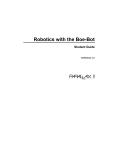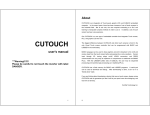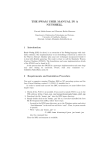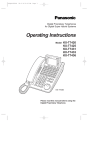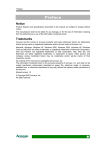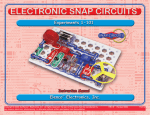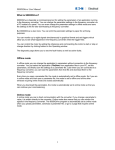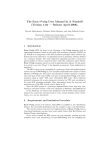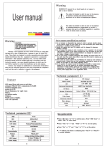Download Java-Based Wireless Robot - The Supercomputing Challenge
Transcript
Java-Based Wireless Robot
New Mexico
Supercomputing Challenge
Final Report
April 7, 2010
Team 81 - Manzano High School
Team Members
Phillip Atencio
Dustin Chavez
Nathan Hassler
Nick Ratzer
David Young
Teacher Sponsor / Project Mentor
Mr. Stephen Schum
Table of Contents
Executive Summary
Introduction
Research and Science Background
Project Overview
Results
Conclusions
References and Acknowledgements
Appendix:
pBasic 2.5 Computer Code
Java Computer Code
Executive Summary:
The purpose of our project was to design, assemble and program two small robots
-- a pBasic-stamp Boe-Bot and a Javelin-stamp Java-Bot to utilize LED’s, “whiskers”,
photo resistors, and IR pairs to perform various maneuvers and environmental detection
tasks, such as detecting and monitoring light, objects, and distances to objects, etc. .
Then we intended to add a small solar panel to make the Java-Bot solar-powered and add
wireless communication with the Java-Bot.
A real-world robot executes essential tasks in hard to reach or dangerous
environments. Robots look for life in burning buildings, they detect dangerous gases and
chemicals in hazardous environments or spills, they monitor radiation, they study far
away planets and moons (Examples: Mars Explorer Rovers) and, in general, they can
access and provide sensory input for a variety of physical parameters in various remote
environments. Once the robots are assembled and functional, scientists and technicians
can communicate programs of instructions to the robots and retrieve data via wireless
technology. Furthermore to reduce the high costs and time demands of rechargeable
batteries, solar panels can be added to provide electrical power to the robot.
During fall 2009, in our Manzano High School class, Pre-Engineering
Electronics, we learned and solved problems for the basic physics topics of velocity,
force, work, power, electric charge, electric fields, DC voltage, DC current, resistance,
Ohms Law, DC series and parallel circuits, and the power formula (P = I V). Then we
spent the past five months assembling and programming a mini-robot with Basic
computer programs to make the robot do a variety of maneuver on a flat surface and to
detect motion and light.. In doing so, we learned some Basic programming techniques
with variables, counter, for loops, etc.
From January through April, we assembled and programmed a similar
Java-based robot to maneuver, plus to perform various maneuvers and to detect light,
shadows, and objects. Next we will also add the wireless component to communicate
programs to the robot and to return data from the robot. Our Java programs will also
output retrieved data to the display. Furthermore we will add small solar panels with
sufficient area to power the robot, hopefully during both natural sunlight and interior
lighting conditions
Introduction
Over the past several months, our group has worked on programming and
assembling a pBasic-based mini-robot and a Javelin-based mini robot that will complete
various complex tasks that a real world robot would normally carry out. Our basic
knowledge of programming began with the pBASIC code and evovled to Javelin (Javabased) code. We wrote programs and assembled the circuit board and robot hardware to
perform various maneuvers and environmental detection tasks, such as detecting and
monitoring light, objects, and distances to objects. Then we modified the programs and
hardware to allow the Boe-Bot and Java-Bot to successfully navigate a complex maze.
This took much of the prior programming and wiring knowledge to achieve an escape
from the maze.
Research and Science Background
Our endeavor began last fall with a review of the foundations of physics – motion,
forces, work, energy, power, static electricity and DC electricity. Upon completion of our
Basic stamp and Javelin stamp robots, we spent much time learning about circuit
diagrams and DC current.
Figure 1. LED Pulse Timing Diagram (Parallax, Inc. “Robotics2_2.pdf”)
Figure 2. LED Circuit Schematic (Parallax, Inc. “Robotics2_2.pdf”)
Figure 3. Photoresistor RC Circuits Schematic (Parallax, Inc. “Robotics2_2.pdf”)
Figure 4. IRED Source IR Detector Diagram (Parallax, Inc. “Robotics2_2.pdf”)
Figure 5. IRED Source IR Detector Diagram (Parallax, Inc. “Robotics2_2.pdf”)
Project Overview:
After we became well versed with comprehending circuit diagrams, we developed
the pBASIC program for the Boe-Bot and assembled a pBASIC-stamp Boe-Bot to
complete various tasks such as detecting light, objects and distance to objects using
LED’s, IRED’s and IR detectors and “whiskers”. Then we wrote a pBasic 2.5 program
(See Appendix.) to allow the Boe-Bot to successfully navigate a complex maze with
multiple turns and corners as well as descending a 45 degree angle, and various obstacles.
(See Figures 1 and 2 below.) Other Boe-Bot programs included photo resistors for light
detection, use of “whiskers” for object detection, an LED on/off switch, a pair of left and
right IRED sources and IR detectors for distance and object detection, and a “shadow
bot” program where one shadow Boe-Bot was able to follow a leading Boe-Bot. (We
found on You-Tube a video of 28 shadow-bots following one lead-bot!!)
Fig 6. Team 81 Boe-Bot Assembled with Whiskers for Object Detection
Fig 7. Team 81 Boe-Bot Attempting to Get Out of the Maze
For the past three months, we have been learning Javelin (a Java-based code)
from a Javelin manual for a, Java-Bot, which has a Javelin stamp located on the circuit
board. And we have been assembling the circuit components on the Java-Bot for the
LED, IRED and IR detector, photo resistors, and “whiskers”. Within the next few weeks,
we expect to have the Java-Bot accomplish the same tasks as those stated above for the
Boe-Bot. This includes programming the Java-Bot to successfully navigate our complex
maze.
Conclusions
We intend to put a solar panel on the Java Bot so that we can run it without using
batteries. Plus we plan to install wireless communication hardware on the Java-Bot. We
will write Java programs that will be communicated to the Java-stamp on the robot circuit
board wirelessly. And the program will allow the robot to wirelessly communicate back
to the computer the sensory output/data acquired by the various sensors placed on the
robot, while being powered by an aftermarket solar panel. Our greatest hope is to become
well versed with Java, and able to send our robot programs, wirelessly, while it is
running. When we are able to successfully communicate with our robot wirelessly, we
will attempt to complete complex tasks that can be easily applied to “real life”
applications which would be too dangerous for any human being to do. Such applications
include, but are not limited to: detecting smoke, body temperature, and light.
Acknowledgements:
Our team would like to acknowledge the NM Supercomputing Challenge Program
for 2009-2010 and Mr. Stephen Schum for teaching the Pre-Engineering Electronics
program here at Manzano High School and for helping us problem solve throughout the
duration of the project. We would also like to give a special thanks to the MHS
Administration for supporting the Pre-Engineering Electronics class.
References:
Zitzewitz, et al (2005), Physics: Principles and Problems, Glencoe, Chap 1-11; 20-24
Lindsay, Andy,(2003-2004), Robotics with the Boe-Bot, Parallax, Inc.
Lindsay, Andy,(2002-2006) , Javelin Stamp User’s Manual, Parallax, Inc.
Lindsay, Andy, (1999-2008), Basic Analog and Digital, Parallax, Inc.
Parallax, Inc. (2009), “Robotics2_2.pdf” on Boe-Bot Resources CD, Parallax, Inc.
http://marsrover.nasa.gov/home/ NASA Mars Explorer Rover Home Page
Appendix
pBasic Code: Boe-Bot Get Out of Maze
' -----[ Team 81 Boe-Bot Get Out of Maze ]---------------------------------------' {$STAMP BS2}
' Stamp directive.
' {$PBASIC 2.5}
' PBASIC directive.
' -----[ Variables ]---------------------------------------------------------pulseCount
counter
VAR
VAR
Byte
Nib
' For...next loop counter.
' Counts alternate contacts.
old7
VAR
Bit
' Stores previous IN7.
old5
VAR
Bit
' Stores previous IN5.
' -----[ Initialization ]----------------------------------------------------FREQOUT 4, 2000, 3000
counter = 1
old7 = 0
' Signal program start/reset.
' Start alternate corner count.
' Make up old values.
old5 = 1
' -----[ Main Routine ]------------------------------------------------------DO
' --- Detect Consecutive Alternate Corners -----------------------' See the "How EscapingCorners.bs2 Works" section that follows this program.
IF (IN7 <> IN5) THEN
' One or other is pressed.
IF (Old7 <> IN7) AND (Old5 <> IN5) THEN ' Different from previous.
counter = counter + 1
old7 = IN7
' Alternate whisker count + 1.
' Record this whisker press
old5 = IN5
' for next comparison.
IF (counter > 4) THEN
counter = 1
' If alternate whisker count = 4,
' reset whisker counter
GOSUB Back_Up
' and execute a U-turn.
GOSUB Turn_Left
GOSUB Turn_Left
ENDIF
ELSE
counter = 1
ENDIF
' ENDIF counter > 4.
' ELSE (old7=IN7) or (old5=IN5),
' not alternate, reset counter.
' ENDIF (old7<>IN7) and
' (old5<>IN5).
ENDIF
' ENDIF (IN7<>IN5).
' --- Same navigation routine from RoamingWithWhiskers.bs2 -----------------IF (IN5 = 0) AND (IN7 = 0) THEN
GOSUB Back_Up
' Both whiskers detect obstacle
' Back up & U-turn (left twice)
GOSUB Turn_Left
GOSUB Turn_Left
ELSEIF (IN5 = 0) THEN
GOSUB Back_Up
' Left whisker contacts
' Back up & turn right
GOSUB Turn_Right
ELSEIF (IN7 = 0) THEN
GOSUB Back_Up
GOSUB Turn_Left
' Right whisker contacts
' Back up & turn left
ELSE
GOSUB Forward_Pulse
ENDIF
' Both whiskers 1, no contacts
' Apply a forward pulse
' and check again
LOOP
' -----[ Subroutines ]-------------------------------------------------------Forward_Pulse:
' Send a single forward pulse.
PULSOUT 13,850
PULSOUT 12,650
PAUSE 20
RETURN
Turn_Left:
' Left turn, about 90-degrees.
FOR pulseCount = 0 TO 9
PULSOUT 13, 650
PULSOUT 12, 650
PAUSE 20
NEXT
RETURN
Turn_Right:
FOR pulseCount = 0 TO 9
PULSOUT 13, 850
PULSOUT 12, 850
PAUSE 20
' Right turn, about 90-degrees.
NEXT
RETURN
Back_Up:
' Back up.
FOR pulseCount = 0 TO 19
PULSOUT 13, 650
PULSOUT 12, 850
PAUSE 20
NEXT
RETURN
' Send a single forward pulse.
PULSOUT 13,850
PULSOUT 12,650
PAUSE 20
RETURN
' Left turn, about 90-degrees.
FOR pulseCount = 0 TO 6
PULSOUT 13, 650
PULSOUT 12, 650
PAUSE 20
NEXT
RETURN
FOR pulseCount = 0 TO 6
PULSOUT 13, 850
' Right turn, about 90-degrees.
PULSOUT 12, 850
PAUSE 20
NEXT
RETURN
' Back up.
FOR pulseCount = 0 TO 6
PULSOUT 13, 650
PULSOUT 12, 850
PAUSE 20
NEXT
RETURN














